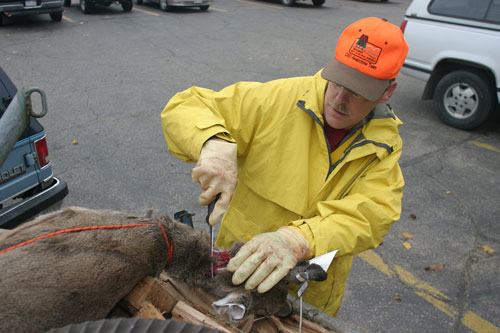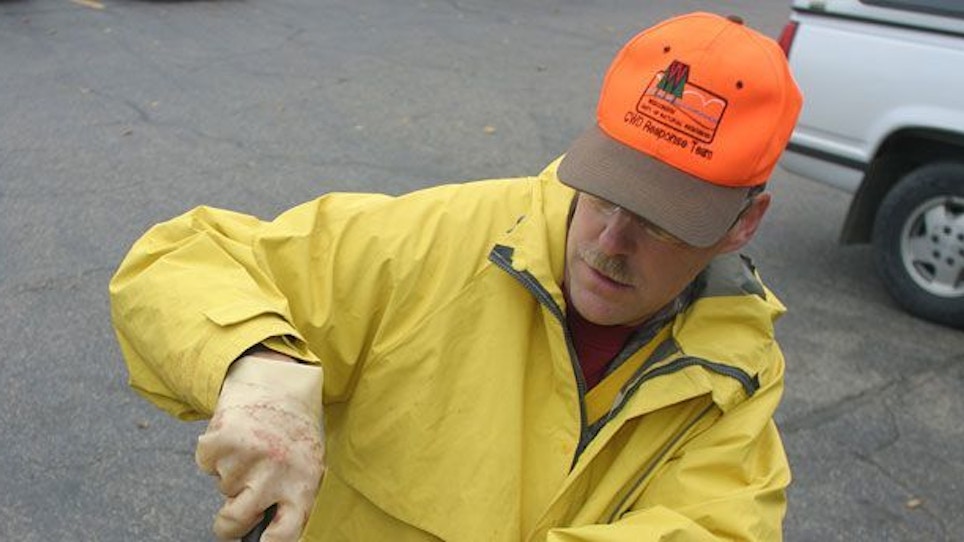 It seems that the alarm bells we heard after the first major outbreak of chronic wasting disease (CWD) in Wisconsin have quieted down — at least for hunters. You will remember that in 2002, wild deer in an area of Wisconsin were found to have CWD, and that outbreak was linked to game farms. In later years we saw more game-farm-related CWD outbreaks in a number of states and provinces, and wildlife agencies were madly trying to cope with the spread. Hunters were, too, but after a few years, when no hunters came down with this “mad cow” deer disease, they relaxed a bit. Calm was a good thing, but the facts are that state wildlife agencies still consider CWD a very big deal with a ton of potential downside for hunting and hunters.
It seems that the alarm bells we heard after the first major outbreak of chronic wasting disease (CWD) in Wisconsin have quieted down — at least for hunters. You will remember that in 2002, wild deer in an area of Wisconsin were found to have CWD, and that outbreak was linked to game farms. In later years we saw more game-farm-related CWD outbreaks in a number of states and provinces, and wildlife agencies were madly trying to cope with the spread. Hunters were, too, but after a few years, when no hunters came down with this “mad cow” deer disease, they relaxed a bit. Calm was a good thing, but the facts are that state wildlife agencies still consider CWD a very big deal with a ton of potential downside for hunting and hunters.
We’ve known for years that the spread of chronic wasting disease is almost always linked to game farms. CWD is one of several prion diseases that attack the brain, and determining the life cycle of such diseases is complex and difficult, to say the least. The bottom line is we don’t know a lot about those prion buggers that cause this disease. We do know that CWD prions survive in soil for years, making them a big problem for deer farmers. Once a farm gets CWD, decontamination is almost impossible, and we have no idea how long the prions can remain viable in the soil. My guess is many, many years. Maybe decades. We know that deer can be placed in an area where CWD-infected animals lived, and after all animals are removed for over a year, healthy deer placed there can contract CWD.
We know that deer have prions in nervous tissue, lymph tissue and even muscles. We know that prions are spread via saliva and urine. (That is why many states are concerned about baiting for deer. Baiting puts a lot of deer together where saliva exchange can take place. Deer farms do the same thing.) We don’t think prions can be spread to most animal species and to humans via eating deer meat, and lab tests on mice support that.
There are still a lot of questions regarding CWD’s impact on wild deer, how we can stop the disease, and what the ties are to deer farms. Googling “game ranching and the spread of chronic wasting disease” provides some interesting information. Game farms are often the source of CWD that then spreads to other farms or to the wild. Ship one contaminated elk or whitetail from one ranch to another, and that second ranch is now a source of the disease for the next ranch, or for the wild. Have a fence go down where an infected deer escapes, and we can end up with CWD in the wild deer herd. There are examples of both scenarios taking place.
Where It’s Struck
In January 2009 a CWD-positive elk was found on a game farm near Pine Ridge in Olmsted County, MN. In November 2010 a bowhunter shot a deer in that area that later tested positive for CWD. I have friends who have a farm there, and they’ve worked hard to get their deer herd shaped up to where they had some great bucks. Now all that work is in jeopardy because that farm is in a zone where efforts are being made to seriously reduce deer numbers to prevent CWD from spreading. But the 2011 hunting season produced no CWD-positive deer, so maybe they will catch a break and get the ability back to manage and hunt big bucks on their land again.
What happened in Minnesota is not an unusual story. A good friend of mine owned a farm that he managed for deer hunting in the panhandle of eastern West Virginia. When chronic wasting disease was found there, the DNR did what they had to do to slow the spread. They hammered the deer. Luckily my friend found a non-hunting, out-of-state buyer for his farm and he was able to sell without losing money. In most instances, when CWD is found, properties in that area where owners were managing for quality deer will suffer, as will property values.
Missouri’s wild deer herd just went positive for CWD, two miles from a deer farm where deer had CWD. I wonder what the landowners in that area think about deer farms and the price of their land after a CWD-infected wild deer popped up?
Nebraska has had CWD in their wild deer since 2002. They most likely got it from Colorado and Wyoming, as well as a contaminated deer ranch in Sioux County, NE. For years there was no CWD found in their wild deer except for the far northwestern corner of Nebraska, but they just announced the finding of CWD in several counties in the center of the state. This shows the difficulty in containing the spread of this disease in the wild.
So what, you say. It’s obvious that CWD can’t spread to humans, and it sure doesn’t seem to be hurting our deer herds. Maybe, but state game agencies are rightfully concerned. Check out www.Chronic-wasting-disease.blogspot.com. After perusing it you will see the concern state agencies have about controlling the spread. Take the state of Wisconsin, for example. A buck shot on the Almond deer farm in 2002 had CWD, and this led to all deer there being killed in 2006. Out of 76 deer killed, 60 were CWD-positive. To keep control of this situation and make sure the fence separating the contaminated farm from wild deer remained intact, the DNR bought the farm in 2011. One notice I read listed the price as more than $400,000. Remember, this farm probably has CWD prions in the soil, so the potential for it to spread to wild deer is real. So far, though, the fence has worked. All 1,200 deer tested around the farm have been negative. The DNR wants to keep it that way, so they bought it and did a total decontamination (though there is no way to know whether prions are still in the soil.). All timber along the fence is being cut to protect it, and a second fence 12 feet from the first is being constructed. Apparently the Wisconsin DNR is very concerned about the spread of CWD. The DNR is doing CWD research on the farm. All of this seems like a good idea.
Baiting And Politics
If piles of corn bring deer together, and we know that saliva exchange spreads CWD, then why is baiting being legalized in more and more states? The reason is simple. Hunters want baiting and they apply political pressure to keep baiting if they have it, or to get baiting if they do not have it. The DNR in my home state of West Virginia would love to stop baiting for deer to prevent, or slow, the spread of CWD (and they have banned baiting in the hot zone for CWD), but hunter pressure has kept it legal in most of the state. It’s a real political hot potato.
Once deer farms and CWD are there, the costs can become huge to inspect and monitor. One report showed that Michigan had approximately 450 deer farms and those farms paid $106,640 in inspection and regulatory program fees in 2009. Sounds good — except for the fact that state taxpayers paid $1.36 million to do that inspection and CWD monitoring work.
There is now a political push to allow deer farming and put control of deer farms under the Department of Agriculture instead of the state wildlife agency in Tennessee. In West Virginia the 2012 push is to take control of deer farms from the Department of Wildlife and give it to Agriculture. Such moves would likely increase the chance of movement of deer from out-of-state deer farms into those states.
The bottom line is our wildlife agencies are very concerned about the impact of CWD on wild deer, and one reason is the hundreds of millions of dollars our deer bring into state economies. Those state DNRs base that concern on things we know and on things we just don’t know about CWD. It’s an experiment in progress and the outcome could impact us all. Stay tuned.






